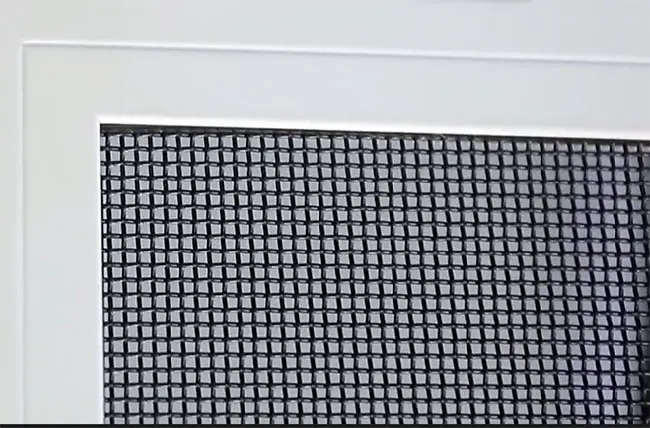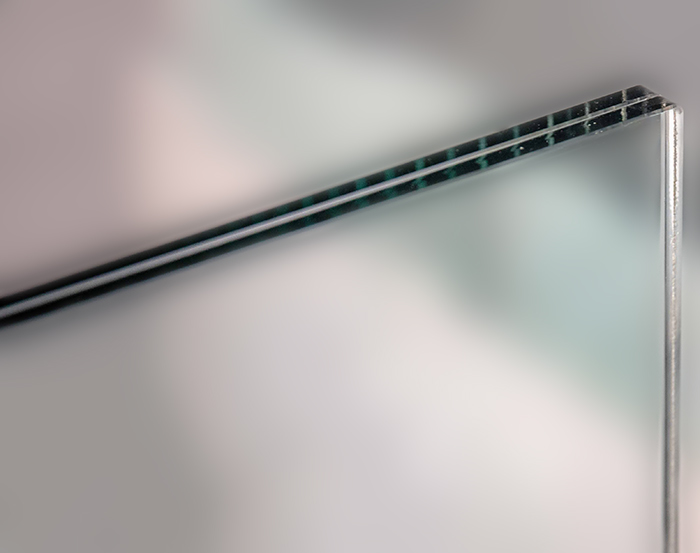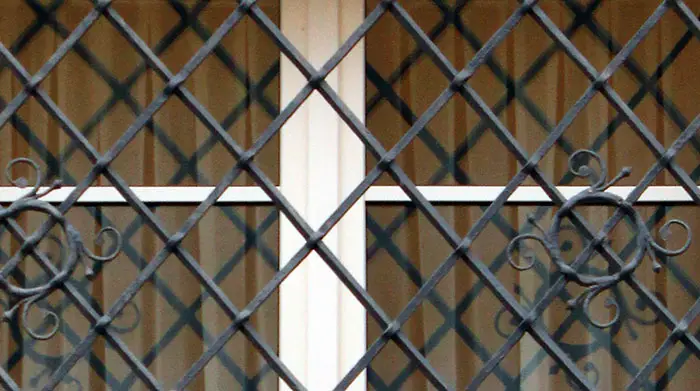According to the statistics, doors are the most common entry points when it comes to burglaries.
Therefore, if you really want to make your home burglar-proof, securing your doors is an essential step.
In fact, a door is only as secure as its weakest part and a door with windows is way more vulnerable than a solid door without any glass.
Fortunately, there are several effective methods to make a door with glass more secure and resistant to forced attacks.
Let’s see how you can do that!
1. Install Security Film to Reinforce Door Glass
When it comes to securing door glass panes or windows right next to the door, one obvious solution is to reinforce the glass itself.
The simplest way to do that is to use window security film.
Security film works as an invisible shield. It’s usually made of polyester and has several laminated layers. Generally, the more layers and thickness it has, the greater resistance it gives. You want to use a window security film that has at least 8 mils (200 microns) of thickness.
Security film prevents the glass from shattering and keeps it together even if the glass is repeatedly subjected to high force.
Keep in mind that some front doors with windows come with preinstalled security film. If that’s the case, you shouldn’t add another layer.
Otherwise, if the window panes in your front door are lacking security film, I highly recommend that you consider adding this type of protection to your door.
Make sure you avoid flimsy products from unknown manufacturers (to be honest, there are plenty on the market). Instead, choose a high-quality security film from a trusted manufacturer. I mainly use 3M products.
Although reinforcing the glass surfaces of your door with security film is a simple yet effective solution, it doesn’t make them impenetrable. What it does, however, is make it more difficult and time-consuming to break through the door glass.
A unique advantage of glass security film is that besides protecting the glass against deliberate attacks, it can also help prevent storm damage.
The film can be applied to front doors, patio doors, sliding doors, French doors, and windows. One caveat though: if you’ve never installed any security film before, I suggest that you either ask someone with sufficient experience or call a professional.
2. Use Glass Break Sensors
If you’re on a budget, using glass break sensors is a reasonable way to improve security.
A glass break sensor recognizes the sound of glass shattering and automatically sounds the alarm. It usually has a 15-30 feet range, therefore a single device is usually enough to secure an exterior door with windows (in most cases it’ll also cover windows next to it) and sidelights.
There are models on the market that detect vibration instead of sound, however, those must be mounted directly on the window and you’ll usually need multiple devices to cover the entire glass surface of the door.
While a glass break sensor can be a useful burglar deterrent, it does not prevent criminals from breaking the window. This is why I usually recommend using it in combination with some kind of physical barrier, such as a security film or security screen.
The main benefits of a glass break sensor are low cost and easy installation. Its major drawback is that it doesn’t prevent entry (but may successfully deter intruders).
There are many types of glass break detectors on the market, and while I haven’t tried all of them, I’ve had a good experience with this model from Honeywell.
Pro Tip: You can add motion detectors to further improve security.
3. Protect Door Windows with Security Screens

If security is a top priority for you, you should definitely consider mounting security screens on your front and patio door windows.
Although a window security screen may look like a bug screen at first glance, don’t be fooled by appearances. A security screen is basically a wire mesh that is usually made of heavy-duty stainless steel.
While window security screens are more expensive than security film, they offer greater protection against high force attacks.
Most security screens are pretty hard to break through and it’s very difficult to disrupt their integrity even with a crowbar.
What I like about security screens is that they allow airflow (while keeping intruders out) and they usually don’t block too much light.
Another benefit is storm protection: they can protect the glass from flying objects during heavy storms, such as a hurricane.
Security screens are often custom-made but you can also find ready-to-use fixed size panels online.
Tip: If you want to protect your entire door (and not just the glass) or you have a sliding glass door (or a French patio door), opt for a door security screen.
Using security screens is a really powerful way to secure window panes in a door or windows near the door. Of course, if you have the budget, you can install them on your windows too. Anyway, you can find some helpful tips on how to burglar-proof all your windows here.
4. Frost Your Door’s Windows
If anyone can easily see through your windows and the glass panels of your door, that can be pretty inviting for criminals. If they know exactly what the rewards are, they’re much more likely to decide to break in to get them.
This is where frosting glass comes in. There are three main ways you can frost your door’s windows.
You can use:
- a special spray (such as this one),
- a removable window film (or frosted security film) or
- an etching cream.
Frosted glass will not only prevent criminals from gaining an insight into your home, but it will also improve your privacy in general. Don’t forget the windows next to the front door either.
If you need a temporary solution or you don’t want to change the glass surface permanently, opt for a non-adhesive removable window film.
5. Install Motion Sensor Lights
Motion sensor lights are in the same category as glass break sensors: they’re burglar deterrents.
Intruders don’t like to be in the spotlight, so you can make them feel uncomfortable by installing a motion sensor light above your entry door or patio door. It’s crucial that you mount the light at least 10 feet high so that it cannot be easily deactivated.
The more types of deterrents you use, the more likely an intruder will find it too risky to break into your home.
The major drawback of motion-activated lights is that they don’t really have too much effect during the daytime. However, that doesn’t mean they can’t prevent nighttime burglaries.
This is a popular solar-powered model.
Tip: If you have the budget, you can take security to the next level by installing a motion-activated floodlight with a built-in cam, such as this one from Ring.
6. Switch to Laminated Glass

At first sight, laminated glass looks exactly like normal glass, however, it’s way more durable and a lot harder to break through.
It’s a type of safety glass that consists of at least two layers of glass and one layer of adhesive film (plastic) in between.
How does it work?
If the glass is subjected to force, it will shatter but the inner layer will hold the pieces together and keep the overall integrity of the panel.
Here’s what I’m talking about:
Similar to a security screen or film, laminated glass can also help protect a door with windows from storm damage.
To be honest, laminated glass is not cheap but it can be a great choice for those who consider security screens unsightly and those who are not a big fan of security film either.
Don’t confuse laminated glass with tempered glass. While it’s true that the latter one is more durable than standard glass, it’s quite easy to break, therefore it won’t prevent forced entries and it’s not suitable for security purposes.
7. Set Up an Alarm System
A reliable home security system can significantly reduce the chance of a successful burglary. Whether crooks are trying to get inside through a door or a window, a properly calibrated alarm system will be activated immediately.
There are many products available, some of them come with a subscription fee, and some will work standalone. I suggest that you choose according to your needs and don’t pay for extra services that aren’t really necessary for you.
If you need 27/4 monitoring without a contract, have a look at SimpliSafe or Ring Alarm. They are both available without monitoring as well and they work with Alexa.
While an alarm system won’t always prevent a home invasion, it provides basic protection against thieves who want to get inside your home by breaking the glass in your door or a window near the front door.
FYI – If you need to lock a door without a lock, here you will find all the best methods.
8. Consider Installing Window Security Bars or Grilles

To be honest, if I had to choose between window bars and security screens, I would pick the latter one.
The reason for this is that I prefer the appearance of security screens to bars. To be fair, there are many types of bars and grilles and not all of them are unattractive.
The main benefit of bars is that they offer a very high level of protection for door glass panels (in certain cases even higher than security screens).
If you want to secure an open window, bars and grilles are one of the best choices to prevent unauthorized entries. Keep in mind however that you should never install non-egress security bars on windows that are emergency exits.
If you’re not a big fan of bars, here you will find the best ways to secure your windows without using them.
9. Deter Burglars with an Outdoor Security Camera
Installing a security camera above the entrance can help protect doors with and without windows.
Most experts agree that video surveillance is an effective deterrent in most cases.
If you need a quick solution, opt for a wireless battery-powered camera, such as this one from Blink.
If you’re on a budget, get a dummy security camera. In this case, try to choose the least popular model to reduce the chances of being recognized by crooks.
You can find more actionable tips on how you can deter burglars in this article.
More Actionable Tips
Remember that a door is only as secure as its weakest part. Reinforcing the windows and glass panels is no substitute for a good quality door lock, sturdy frames, strike plates, and hinges.
If you have unprotected glass panes near your door, the main issue is that burglars can easily break the glass and reach in to open the lock. This is where a reliable door lock comes in.
If you want to reinforce a door, one of the first steps should be to install a heavy-duty ANSI Grade 1 deadbolt, such as this one from Kwikset. This will provide a very high level of residential security.
It’s extremely important that you reinforce all the essential parts of your door. You can find all the best ways you can improve front door security in this guide. If you want to make your door kick-proof, don’t miss this article. For more protection, consider replacing your old door with a security door.












